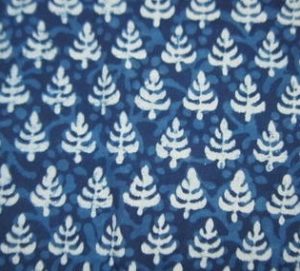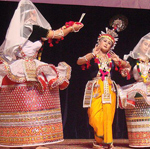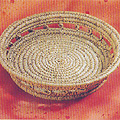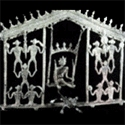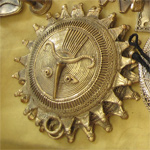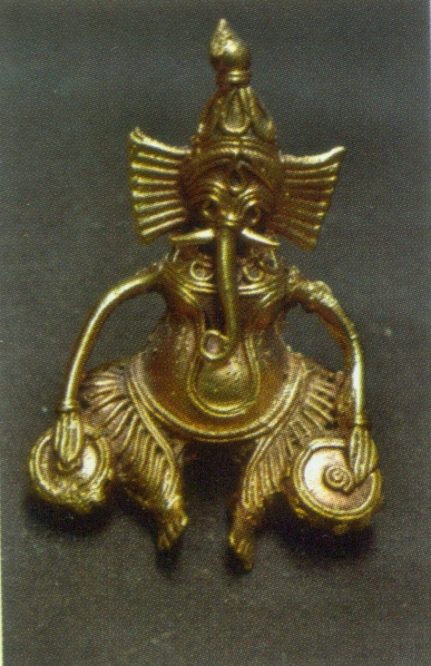Dabu Print of Gujarat,
Dabu print is a form of mud-resist painting which is popular among the block printers of Deesa, Ahmedabad and Jamnagar. The grey fabric is first washed and printed with a paste made from mud and a local gum called baval. The fabric is put into vegetable pits and washed in running water. After drying it under the sun, it is treated with dyes and chemicals to achieve the desired colour. The fabric is washed every time a new colour is introduced, making it soft and easy to drape. Dabu fabrics are very popular with the tribal and rural communities, for making ghaghara (skirts) and odhanan (veils) .
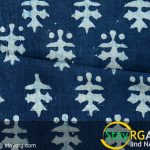
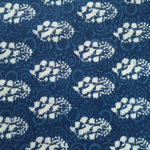
Dabu print is a form of mud-resist painting which is popular among the block printers of Deesa, Ahmedabad and Jamnagar. The grey fabric is first washed and printed with a paste made from mud and a local gum called baval. The fabric is put into vegetable pits and washed in running water. After drying it under the sun, it is treated with dyes and chemicals to achieve the desired colour. The fabric is washed every time a new colour is introduced, making it soft and easy to drape. Dabu fabrics are very popular with the tribal and rural communities, for making ghaghara (skirts) and odhanan (veils) .



Dabu/Hand Block Printing of Rajasthan,
Dabu is a hand block printing technique involving several which requires lot of vigour. This technique is mainly practiced in Bagru city, Jaipur. Dabu printing process involves washing of the fabric followed by sun drying to remove impurities. The pieces of cloth are then laid upon huge printing tables. After this, mud resist paste is prepared with gum, mud and waste wheat chaff. The carved wooden blocks are dipped in this mud resist paste and imprinted on the fabric. The fabric is then dried under the sun. Once dried, the fabric is dipped in dye to acquire the desired colour. The fabric is cleansed again to ensure that all excess dye is removed. Common motifs that are usually printed are geometric patterns, floral patterns, birds, animal forms etc.
Dabu is a hand block printing technique involving several which requires lot of vigour. This technique is mainly practiced in Bagru city, Jaipur. Dabu printing process involves washing of the fabric followed by sun drying to remove impurities. The pieces of cloth are then laid upon huge printing tables. After this, mud resist paste is prepared with gum, mud and waste wheat chaff. The carved wooden blocks are dipped in this mud resist paste and imprinted on the fabric. The fabric is then dried under the sun. Once dried, the fabric is dipped in dye to acquire the desired colour. The fabric is cleansed again to ensure that all excess dye is removed. Common motifs that are usually printed are geometric patterns, floral patterns, birds, animal forms etc.
Dance Costumes of Manipur,
Manipuri dance form is a traditional dance form of Manipur that originated during the reign of King Bhagya Chandra (1763-1798). The costume of the dance was also designed by the King himself. It is said that the king had a dream that helped him develop the costume of Manipuri dance. The costumes of Manipur are bright in colours and beautifully ornated with embroidery. The Manipuri dance has its root in legend and mythology. The dance is based on Krishna leela and Raas leela themes. Where the Radha wears a Green coloured skirt and the other gopis wear red coloured skirts as a distinguishing mark. The male attire is always in orange and saffron colour. So the Krishna wears saffron coloured dress. Potlei is the name given to the Raas costume of Sri Radhika and the Gopis, The main components of the Manipuri dance costumes are as follows: Head Accessories
Manipuri dance form is a traditional dance form of Manipur that originated during the reign of King Bhagya Chandra (1763-1798). The costume of the dance was also designed by the King himself. It is said that the king had a dream that helped him develop the costume of Manipuri dance. The costumes of Manipur are bright in colours and beautifully ornated with embroidery. The Manipuri dance has its root in legend and mythology. The dance is based on Krishna leela and Raas leela themes. Where the Radha wears a Green coloured skirt and the other gopis wear red coloured skirts as a distinguishing mark. The male attire is always in orange and saffron colour. So the Krishna wears saffron coloured dress. Potlei is the name given to the Raas costume of Sri Radhika and the Gopis, The main components of the Manipuri dance costumes are as follows: Head Accessories
- Koknaam: Gauze overhead, embossed with silver Zari.
- Leitreng: Golden ring round the head.
- Koktombi: Cap covering the head.
- Chura: Made of peacock feathers, wired on top of head.
- Meikhumbi: A transparent and thin veil thrown over the head.
- Choli: A tight fitted blouse worn on top of the skirt. It is brightly coloured to match with the skirt.
- Kumin: An Embroidered brightly colored silk or satin skirt.
- Pasuan: A short flair of silver gauze over the Kumin.
- Khangoi: Small rectangular belt over the Pasuan.
- khaon: Rectangular embroidered piece with belt.
- Thabret: A griddle round the waist.
- Feichom: Dhoti; a saffron dress; Male attire.
- Ghungur: Ornament for the foot.
Danke ka Kaam / Embroidery with Metal Pieces and Zardozi of Rajasthan,
Danke Ka kaam, is an unusual and unique textile surface ornamentation technique that is practised in Udaipur, in the Mewar region of Rajasthan. Using small diamond shaped concave relief formed cut pieces of sheet metals that are hand-stitched on to fabrics with zari yarn, it is further complemented by Zardozi embroidery that is worked around it. Earlier only real gold, and silver sheet metal was used to make the Danka, while gold and siver-plated metals are now in use. Embroidered on luxurious textiles like silk and velvet the embroidery has an opulent four-D look with the added cache of the concave shape glinting when it catches the light. Danka builds up motifs like paisleys, flowers and peacocks, borders, vines and scrolls to create sumptuous textile garments. A languishing craft practice Danka embroidery is practiced only by the Bohra Muslim community who migrated to this area in the 16th Century and continue to practice it till today in this corner of Rajasthan. The community themselves do not throw any clear light on the origins of this craft and as to whether it was already being practiced at that time or before or if it traveled to the subcontinent during their migration here cannot be clearly established because of lack of any written or oral history about the craft.
Danke Ka kaam, is an unusual and unique textile surface ornamentation technique that is practised in Udaipur, in the Mewar region of Rajasthan. Using small diamond shaped concave relief formed cut pieces of sheet metals that are hand-stitched on to fabrics with zari yarn, it is further complemented by Zardozi embroidery that is worked around it. Earlier only real gold, and silver sheet metal was used to make the Danka, while gold and siver-plated metals are now in use. Embroidered on luxurious textiles like silk and velvet the embroidery has an opulent four-D look with the added cache of the concave shape glinting when it catches the light. Danka builds up motifs like paisleys, flowers and peacocks, borders, vines and scrolls to create sumptuous textile garments. A languishing craft practice Danka embroidery is practiced only by the Bohra Muslim community who migrated to this area in the 16th Century and continue to practice it till today in this corner of Rajasthan. The community themselves do not throw any clear light on the origins of this craft and as to whether it was already being practiced at that time or before or if it traveled to the subcontinent during their migration here cannot be clearly established because of lack of any written or oral history about the craft.
Date Palm Leaf and Fibre of Andhra Pradesh,
This craft is found mainly in a suburb of Hyderabad called Barkas where a concentration of artisans, mostly of Arab origin, make bags and baskets out of date-palm fibre. The same craft is also practised at Nidadavolu in West Godavari district.
This craft is found mainly in a suburb of Hyderabad called Barkas where a concentration of artisans, mostly of Arab origin, make bags and baskets out of date-palm fibre. The same craft is also practised at Nidadavolu in West Godavari district.
Date, Palm Leaf, Straw and Palmyra and Other Leaf Mats and Baskets,
Besides the better known coir mats woven in Bangladesh a variety of natural materials are used to weave and craft baskets and mats. A large range of baskets for holding grain, dehydrated foods, spices and vegetables are made out of palm (taal) and date (khejur) tree leaves. The unique aspect of these baskets and containers is the use of lengths of rushes and riverside straw as the inner fibres or filling, that are wrapped over with the palm and date leaves. Different varieties of leaves are used to create products of everyday use in Bangladesh. Leaf mats are mainly crafted in the deltaic region in the southern part of Bangladesh. These are mainly utilitarian, everyday consumables used for sitting, or for sleeping, as packaging material and for other every day uses. In the Panchnagar region of Bangladesh coiled and plaited baskets are crafted out of sun-grass. Chatai mats are also woven from the fan shaped leaves of the Palmyra palm without the use of any cotton thread, while the kusana are made of kusa grass (Eragrostis cynosyroides)
Besides the better known coir mats woven in Bangladesh a variety of natural materials are used to weave and craft baskets and mats. A large range of baskets for holding grain, dehydrated foods, spices and vegetables are made out of palm (taal) and date (khejur) tree leaves. The unique aspect of these baskets and containers is the use of lengths of rushes and riverside straw as the inner fibres or filling, that are wrapped over with the palm and date leaves. Different varieties of leaves are used to create products of everyday use in Bangladesh. Leaf mats are mainly crafted in the deltaic region in the southern part of Bangladesh. These are mainly utilitarian, everyday consumables used for sitting, or for sleeping, as packaging material and for other every day uses. In the Panchnagar region of Bangladesh coiled and plaited baskets are crafted out of sun-grass. Chatai mats are also woven from the fan shaped leaves of the Palmyra palm without the use of any cotton thread, while the kusana are made of kusa grass (Eragrostis cynosyroides)
TECHNIQUE AND PROCESS
Palm or date leaf baskets are crafted by first drying, then slicing - with a blade and clipping with scissors – the leaves to the required size. They are then soaked in water for about fifteen minutes to make them more plastic and pliable.
The artisan selects a bunch of long rushes, grass or straw and holding the sheaf (about as thick as a small finger) deftly starts winding the sliced palm/date leaf strips over the straw, binding it in the process.
The basket centre begins to take a circular shape from the central core and is worked from the inside to the outer rim by increasing the ring into wider and wider circles, and raising the walls by pilling coil upon coil and fastening it at regular intervals.
The basket may have a tightly covered palm leaf covering around each coil or more widely spaced out strips of palm/ date leaves allowing the inner sheaf of rushes or straw to be visible. The spiral weave of the basket is held in place by interlacing the palm leaf strips between each layer, thus eliminating any extra binding or sewing together. Varnish is applied as the final step to finish the product.
Dhabla/Tangail/Shawls of Gujarat,
Dhabla shawls are a basic necessity in the rural life in the semi-desert land of the Rann of Kutch. The shawls are woven on a traditional pit-loom, by using both cotton and woollen yarn. A pre-planned designs is transferred on the loom with the help of threads. Then warp of the required colour is put on the loom with the aid of kanji (or starch). The number of yarn threads required by the design are tied and connected with pedals. When the pedal is operated, the particular warp thread comes up, making way for the weft thread to pass through the ruler. Thus, weaving is carried out by the application of a simple up-and-down technique. The colours commonly used include yellow, red, black, green, and orange. The rough wool collected from sheep is the prime raw material used by the Vankar community. Tangali weaving is practised in the Surendranagar district in the Saurashtra region. Without any mechanical device, the design components are reinforced on the fabric itself in a unique manner. The design is embedded on the fabric by twisting loose white cotton or woollen yarn around a group of two or three warp threads and incorporating them into the fell of the cloth, giving a bead-like appearance on the surface.
Dhabla shawls are a basic necessity in the rural life in the semi-desert land of the Rann of Kutch. The shawls are woven on a traditional pit-loom, by using both cotton and woollen yarn. A pre-planned designs is transferred on the loom with the help of threads. Then warp of the required colour is put on the loom with the aid of kanji (or starch). The number of yarn threads required by the design are tied and connected with pedals. When the pedal is operated, the particular warp thread comes up, making way for the weft thread to pass through the ruler. Thus, weaving is carried out by the application of a simple up-and-down technique. The colours commonly used include yellow, red, black, green, and orange. The rough wool collected from sheep is the prime raw material used by the Vankar community. Tangali weaving is practised in the Surendranagar district in the Saurashtra region. Without any mechanical device, the design components are reinforced on the fabric itself in a unique manner. The design is embedded on the fabric by twisting loose white cotton or woollen yarn around a group of two or three warp threads and incorporating them into the fell of the cloth, giving a bead-like appearance on the surface.
Dhalapathar Parda and Fabrics of Odisha,
About a century ago a community known as Rangani producea number of beautiful Pardas or curtains through a special weaving technique in the village of Dhalapathar in Odisha. The temple designs on the Parda have an aesthetic look and became very popular as they gave the doors in any home a temple-like appearance. As a result, the weavers recreated all the famous temples of Orissa like the Puri Jagannath Temple, Konark Temple, Lingaraj Temple and others on Pardas.
About a century ago a community known as Rangani producea number of beautiful Pardas or curtains through a special weaving technique in the village of Dhalapathar in Odisha. The temple designs on the Parda have an aesthetic look and became very popular as they gave the doors in any home a temple-like appearance. As a result, the weavers recreated all the famous temples of Orissa like the Puri Jagannath Temple, Konark Temple, Lingaraj Temple and others on Pardas.
Dhaniakhali Sari Weaving of West Bengal,
Dhaniakhali is an administrative division in Chinsurah subdivision of Hooghly district in West Bengal. It is also one of the places where the craft of weaving Jamdani Sarees is practiced. After the partition of Bengal, India was only left with Dhaniakhali, Shantipur and Phulia for its traditional Bengali handloom sarees. Of these the best can be said to be woven in the Dhanikhali, where every household has at least one loom. Hence, it is no surprise that the saree is named after the place. Earlier the area was famous for its superfine dhotis, but has now shifted to exclusively producing sarees, due to the fall in demand. In order to cater to the needs of the changing market, the weavers are now aspiring to also weave material for salwar-kurtas. The material used for the Dhanikhali saree is coarse and heavier as compared to other textiles from Bengal. However it is meets the middle class budget. The Dhanikhali saree is characterised by the white yarn with 100 by 100 cotton thread count, borders between 1.5 and 2 inches and a 5.5 metres drape. It takes a minimum of two days (10-12 hours each day) to weave an ordinary Dhanikhali saree, for which the weaver may collect up to Rs. 50. This would sell for Rs. 100 in the market. On the other hand the most exotic ones take four to five days to be woven and which would fetch the craftsperson Rs. 450, when sold for Rs. 800. A while back due to the competition it faced from the machine-made cheaper cotton sarees, the craft was fighting for its existence. While at least 55% of the weavers of Dhanikhali are members of a co-operative, Dhanikhali Union Tant Silpi Samabaya Samity, the rest have to deal with middlemen to earn a living. This is because the cooperative does not have means to help all the weavers, when they can barely help this 55%. However, when Mamta Banerjee, an ardent supporter of the Dhaniakhali saree, swept the West Bengal elections, the Dhanikhali saree now famously known as the Mamta saree, became an icon. While her fans are placing bulk orders with the weavers, the retail markets of Kolkata too are stocking the Mamta saree in large numbers to meet the growing demand in the city. Mamta's slogan of Ma, Mati, Manush has also become a part of the saree with the weavers incorporating the three words in the borders of the saree.
Dhaniakhali is an administrative division in Chinsurah subdivision of Hooghly district in West Bengal. It is also one of the places where the craft of weaving Jamdani Sarees is practiced. After the partition of Bengal, India was only left with Dhaniakhali, Shantipur and Phulia for its traditional Bengali handloom sarees. Of these the best can be said to be woven in the Dhanikhali, where every household has at least one loom. Hence, it is no surprise that the saree is named after the place. Earlier the area was famous for its superfine dhotis, but has now shifted to exclusively producing sarees, due to the fall in demand. In order to cater to the needs of the changing market, the weavers are now aspiring to also weave material for salwar-kurtas. The material used for the Dhanikhali saree is coarse and heavier as compared to other textiles from Bengal. However it is meets the middle class budget. The Dhanikhali saree is characterised by the white yarn with 100 by 100 cotton thread count, borders between 1.5 and 2 inches and a 5.5 metres drape. It takes a minimum of two days (10-12 hours each day) to weave an ordinary Dhanikhali saree, for which the weaver may collect up to Rs. 50. This would sell for Rs. 100 in the market. On the other hand the most exotic ones take four to five days to be woven and which would fetch the craftsperson Rs. 450, when sold for Rs. 800. A while back due to the competition it faced from the machine-made cheaper cotton sarees, the craft was fighting for its existence. While at least 55% of the weavers of Dhanikhali are members of a co-operative, Dhanikhali Union Tant Silpi Samabaya Samity, the rest have to deal with middlemen to earn a living. This is because the cooperative does not have means to help all the weavers, when they can barely help this 55%. However, when Mamta Banerjee, an ardent supporter of the Dhaniakhali saree, swept the West Bengal elections, the Dhanikhali saree now famously known as the Mamta saree, became an icon. While her fans are placing bulk orders with the weavers, the retail markets of Kolkata too are stocking the Mamta saree in large numbers to meet the growing demand in the city. Mamta's slogan of Ma, Mati, Manush has also become a part of the saree with the weavers incorporating the three words in the borders of the saree.
Dharmavaram Pattu Sarees and Paavadais of Andhra Pradesh,
Dhamavaram is well known throughout the country for its silk weaving industry, particularly its elegant silk sarees. Evidence of the origin of Dharmavaram Sarees can also be found in the wall paintings of Lepakshi temple near Hindupur. Mulberry silk in 2-ply are used for both the warp and weft. Zari is extensively used in the borders, pallu and body to ornament the saree.
Dhamavaram is well known throughout the country for its silk weaving industry, particularly its elegant silk sarees. Evidence of the origin of Dharmavaram Sarees can also be found in the wall paintings of Lepakshi temple near Hindupur. Mulberry silk in 2-ply are used for both the warp and weft. Zari is extensively used in the borders, pallu and body to ornament the saree.
Dharmavaram Silk Sari of Andhra Pradesh,
Dharmavaram in Anantapur district in Andhra Pradesh is very well known for its silk saris, which bespeak enormous grandeur and yet have a fairly low count of gold thread. The designs and motifs are traditional and include butis and dots. The saris have broad borders and brilliant colour combinations.
Dharmavaram in Anantapur district in Andhra Pradesh is very well known for its silk saris, which bespeak enormous grandeur and yet have a fairly low count of gold thread. The designs and motifs are traditional and include butis and dots. The saris have broad borders and brilliant colour combinations.
Dhokra Metal Casting of Jharkhand,
Metal-casting is done by the community of nomadic craftsmen called malhores who move from place to place collecting old brass scrap and casting images of gods and goddesses and other items such as diyas, anklets, and bells worn by tribals These metal smiths not only make vessels but also the tools for other artisans. The tribal communities engaged in blacksmithy in the Chhota Nagpur area are the Asur Birja tribals, who are said to be the oldest inhabitants of the area. Isolated from modern influences they continue to fashion folk deities and other articles that draw their inspiration from nature. They obtain the raw material from smelting ore taken from the hills or from melting scrap. The Asurs supply the tools needed for hunting, house construction, and cultivation. The shaping is done by hammering the sheet metal or ingot while heating or by pouring into clay or wax moulds. They use brass, an alloy of zinc and copper, and panchdhatu (five elements), an alloy of copper, zinc, gold, silver, and lead, along with bell-metal, an alloy of tin and copper which has a soft tint of old gold. Two distinct types of products made in brass ware and bell-metal these days are cast pots and bowls with the lower half black or a natural dark colour, and dhokra articles, mostly figures of riders and elephants, pradip (candle stands), and the fish type of sindhurdan (vermilion box) made by the cire-perdue or lost wax process. The flexible brass and silver fish made by a goldsmith community concentrated at Haveli Kharagpur in Monghyr district deserves special mention.
Metal-casting is done by the community of nomadic craftsmen called malhores who move from place to place collecting old brass scrap and casting images of gods and goddesses and other items such as diyas, anklets, and bells worn by tribals These metal smiths not only make vessels but also the tools for other artisans. The tribal communities engaged in blacksmithy in the Chhota Nagpur area are the Asur Birja tribals, who are said to be the oldest inhabitants of the area. Isolated from modern influences they continue to fashion folk deities and other articles that draw their inspiration from nature. They obtain the raw material from smelting ore taken from the hills or from melting scrap. The Asurs supply the tools needed for hunting, house construction, and cultivation. The shaping is done by hammering the sheet metal or ingot while heating or by pouring into clay or wax moulds. They use brass, an alloy of zinc and copper, and panchdhatu (five elements), an alloy of copper, zinc, gold, silver, and lead, along with bell-metal, an alloy of tin and copper which has a soft tint of old gold. Two distinct types of products made in brass ware and bell-metal these days are cast pots and bowls with the lower half black or a natural dark colour, and dhokra articles, mostly figures of riders and elephants, pradip (candle stands), and the fish type of sindhurdan (vermilion box) made by the cire-perdue or lost wax process. The flexible brass and silver fish made by a goldsmith community concentrated at Haveli Kharagpur in Monghyr district deserves special mention.
Dhokra/Lost Wax Metal Casting of Andhra Pradesh/Telangana,
The craft of Adilabad Dokra is a tradition of the Woj community of Telangana. These brass metal items represent cultural symbols of their community from idols of gods and goddesses, decorative items to personal accessories and ornaments worn by men and women. The Wojaris, also called Otaris have knowledge of craft making since antiquity. The technique of hand crafting follows the traditional lost wax method with the item to be cast having a core of clay. Each piece is separately molded and handcrafted; the mold being constantly remade results in no two pieces being similar in shape and size with each being distinctive and individualistic. In spite of a growing demand the craftspersons continue with their traditional technique with each product crafted being unique from the idols to their metal representations of animals and plants.
The craft of Adilabad Dokra is a tradition of the Woj community of Telangana. These brass metal items represent cultural symbols of their community from idols of gods and goddesses, decorative items to personal accessories and ornaments worn by men and women. The Wojaris, also called Otaris have knowledge of craft making since antiquity. The technique of hand crafting follows the traditional lost wax method with the item to be cast having a core of clay. Each piece is separately molded and handcrafted; the mold being constantly remade results in no two pieces being similar in shape and size with each being distinctive and individualistic. In spite of a growing demand the craftspersons continue with their traditional technique with each product crafted being unique from the idols to their metal representations of animals and plants.
Dhokra/Lost Wax Metal Casting of Odisha,
The traditional bell-metal craft popularly called dhokra is a typical tribal craft with its mesh- like features giving it its distinctive beauty. Tribal families in villages near Dhenkaral town cast boxes, figures of gods and goddesses, and lamps using the lost wax technique. Craftspersons are spread out throughout the state, making various religious and household utensils. The kansari community of Odisha are experts at making bell-metal cook ware. Bell- metal has a gold tinted surface and is made from an alloy of copper and brass. Bolangir district of Odisha is famous for its silver ware. A heavily ornamented plate, traditionally used for offering betel leaves and nuts, has its inner space divided into many parallel circular rings, each carved out beautifully. The outer ring has flower beds, the second has creepers, the third has fruits, and the innermost illustrates a butterfly sucking honey from flowers. The edges consist of semi-circular curvatures with figures of the moon and a star on each of the protruding portions.
The traditional bell-metal craft popularly called dhokra is a typical tribal craft with its mesh- like features giving it its distinctive beauty. Tribal families in villages near Dhenkaral town cast boxes, figures of gods and goddesses, and lamps using the lost wax technique. Craftspersons are spread out throughout the state, making various religious and household utensils. The kansari community of Odisha are experts at making bell-metal cook ware. Bell- metal has a gold tinted surface and is made from an alloy of copper and brass. Bolangir district of Odisha is famous for its silver ware. A heavily ornamented plate, traditionally used for offering betel leaves and nuts, has its inner space divided into many parallel circular rings, each carved out beautifully. The outer ring has flower beds, the second has creepers, the third has fruits, and the innermost illustrates a butterfly sucking honey from flowers. The edges consist of semi-circular curvatures with figures of the moon and a star on each of the protruding portions.
Dhokra/Lost Wax Metal Casting of West Bengal,
The craft of Dhokra metal casting, said to be the oldest form of the craft, is named after the tribe Dhokra Damar, the traditional metal smiths of West Bengal. The tribe is spread across Jharkhand and West Bengal and Orissa. The members of this tribe are distant cousins of the Chhattisgarh Dokras. The Dhokra Damar's were initially a nomadic tribe, who have now left their nomadic character. Due to this their roots can be found in Central and Easter India and as far south as Kerala and as far north as Rajasthan. The crafts persons may also be found to have settled in some areas of Burdwan, Bankura and Midnapur districts of West Bengal. Most of such craftsmen had left the craft leaving only a few families in the trade. The technical name for Dokra system of metal casting is 'cire perdue' or lost wax process. The process involves moulding a replica of the desired product with wax on a clay core with fine details of designs and decorations. A few coats of finely prepared clay paste is applied over the model and left to dry in the shade. This technique helps create a hollow cast, in which the wax is replaced with molten metal. Usually brass scrap is used as raw material. The major items that they manufacture are measuring cutlery of different sizes, anklets for the Santhals. Using the lost wax process they make paikona, dhunuchi, pancha pradeep, anklets and ghunghrus with mixed aluminium. Dhokra castings usually also include of home beautification accessories like lamp holders, lamps, chains, and a variety of symbols of ethnic folklore and religion, and beautiful tribal jewellery of tribal Indian designs and patterns. In current years, this undying tradition of brilliantly fashioned, decorated and handcrafted goods of Dokra artisans are in enormous demand in domestic and foreign marketplace because of it archaic plainness and enthralling folk motifs. Untutored in recognized institutions, the talent and artistic rationality of these people are the outcome of the instinctive and intuitive innovative sense evolved over thousands of years.
The craft of Dhokra metal casting, said to be the oldest form of the craft, is named after the tribe Dhokra Damar, the traditional metal smiths of West Bengal. The tribe is spread across Jharkhand and West Bengal and Orissa. The members of this tribe are distant cousins of the Chhattisgarh Dokras. The Dhokra Damar's were initially a nomadic tribe, who have now left their nomadic character. Due to this their roots can be found in Central and Easter India and as far south as Kerala and as far north as Rajasthan. The crafts persons may also be found to have settled in some areas of Burdwan, Bankura and Midnapur districts of West Bengal. Most of such craftsmen had left the craft leaving only a few families in the trade. The technical name for Dokra system of metal casting is 'cire perdue' or lost wax process. The process involves moulding a replica of the desired product with wax on a clay core with fine details of designs and decorations. A few coats of finely prepared clay paste is applied over the model and left to dry in the shade. This technique helps create a hollow cast, in which the wax is replaced with molten metal. Usually brass scrap is used as raw material. The major items that they manufacture are measuring cutlery of different sizes, anklets for the Santhals. Using the lost wax process they make paikona, dhunuchi, pancha pradeep, anklets and ghunghrus with mixed aluminium. Dhokra castings usually also include of home beautification accessories like lamp holders, lamps, chains, and a variety of symbols of ethnic folklore and religion, and beautiful tribal jewellery of tribal Indian designs and patterns. In current years, this undying tradition of brilliantly fashioned, decorated and handcrafted goods of Dokra artisans are in enormous demand in domestic and foreign marketplace because of it archaic plainness and enthralling folk motifs. Untutored in recognized institutions, the talent and artistic rationality of these people are the outcome of the instinctive and intuitive innovative sense evolved over thousands of years.
Dhurrie Weaving of Odisha,
This craft is very common at Cuttack and Baripada. These cotton dhurries are hand-woven, using a frame with a combination of strong thread and soft, cotton surface thread. This craft is practised by the inmates of Cuttack and Baripada Central Jails, as a source of occupation and income.
This craft is very common at Cuttack and Baripada. These cotton dhurries are hand-woven, using a frame with a combination of strong thread and soft, cotton surface thread. This craft is practised by the inmates of Cuttack and Baripada Central Jails, as a source of occupation and income.
